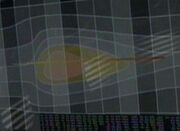m (lk fix) |
No edit summary |
||
| Line 3: | Line 3: | ||
__NOTOC__ |
__NOTOC__ |
||
[[File:Temporal causality loop.jpg|thumb|A schematic of the ''Enterprise''-D's course through a rupture]] |
[[File:Temporal causality loop.jpg|thumb|A schematic of the ''Enterprise''-D's course through a rupture]] |
||
| − | '''Space''', also known as '''spacetime''' or more fully as the '''spacetime continuum''', is the plane of existence home to the known [[universe]]. |
+ | '''Space''', (the final frontier) also known as '''spacetime''' or more fully as the '''spacetime continuum''', is the plane of existence home to the known [[universe]]. |
When a [[starship]] reaches the speed of [[warp 10]], it goes into [[subspace]] and exists at every point in space at once, in superposition. ({{VOY|Threshold}}) Exceeding warp 10 would allow a starship to travel backwards in time. ({{TNG|Time Squared}}) |
When a [[starship]] reaches the speed of [[warp 10]], it goes into [[subspace]] and exists at every point in space at once, in superposition. ({{VOY|Threshold}}) Exceeding warp 10 would allow a starship to travel backwards in time. ({{TNG|Time Squared}}) |
||
Revision as of 05:18, 9 August 2013
Template:Disambiguate Template:Disambiguate

A schematic of the Enterprise-D's course through a rupture
Space, (the final frontier) also known as spacetime or more fully as the spacetime continuum, is the plane of existence home to the known universe.
When a starship reaches the speed of warp 10, it goes into subspace and exists at every point in space at once, in superposition. (VOY: "Threshold") Exceeding warp 10 would allow a starship to travel backwards in time. (TNG: "Time Squared")
The Krenim weapon ship, used by Annorax, worked by pushing the target outside the spacetime continuum, thus deleting it from history. (VOY: "Year of Hell")
Disruption to the spacetime continuum can have serious repercussions. In 2368, for example, the USS Enterprise-D unknowingly entered a rupture in the spacetime continuum, which threw the ship and its crew into a temporal causality loop, experiencing the same time frame over and over. (TNG: "Cause and Effect")
Similar phenomena, such as spatial ruptures or subspace rifts, have been encountered by numerous starships throughout the galaxy.
The term deep space describes areas of space that are farther than one's own star system. This term is used in Starfleet nomenclature to describe the location of certain types of starbases, outposts and space stations. For example, Deep Space Station K-7 or Deep Space 9 are named based on their deep space locales. (TOS: "The Trouble with Tribbles"; Star Trek: Deep Space Nine)
According to records, the USS Farragut was the first deep space assignment of Lieutenant James Kirk. (TOS: "Obsession")
In 2266, on the stand in a court martial proceeding, Dr. McCoy was cited on record as an expert in psychology, especially space psychology, which was defined as "patterns which develop in the close quarters of a ship during long voyages in deep space." (TOS: "Court Martial")
In 2268, Spock described the damage to the space probes Nomad and Tan-Ru as occurring in deep space. Later, Captain Kirk ordered the errant amalgam of the two probes beamed to a set of coordinates that were specified as being in deep space. (TOS: "The Changeling")
Kirk also specified deep space as a target when Redjac, inhabiting the body of Hengist, was transported off the Enterprise. (TOS: "Wolf in the Fold")
When Lieutenant Mira Romaine came aboard USS Enterprise, Dr. McCoy and Montgomery Scott had a discussion about how their experience told them that someone's first trip into deep space can affect them. (TOS: "The Lights of Zetar")
The USS Voyager was the first Federation ship which tested a class nine warp drive in deep space. (VOY: "Relativity")
After the first contact with the Voyager in 2374, Starfleet redirected two deep space vessels toward Voyager's position. (VOY: "Life Line")
Deep space stations
Appendices
Background information
A few Star Trek-related people have been to "outer space," briefly leaving Earth's atmosphere. Astronaut Mae Jemison has flown on a space shuttle, while Terry Virts flew the shuttle itself in 2010. E. Michael Fincke has served aboard the International Space Station. Stephen Hawking participated in a zero-gravity flight. Gene Roddenberry and James Doohan have both had their ashes flown to outer space. A tiny model of the USS Enterprise has also flown aboard a space shuttle.
Related topics
- Albert Einstein
- Deep space assignment
- Dimension
- Space-time continuum
- Stephen Hawking
- Subspace
- Time
- Transwarp
- Universe
- Q Continuum
- Quantum reality
- Quantum slipstream
